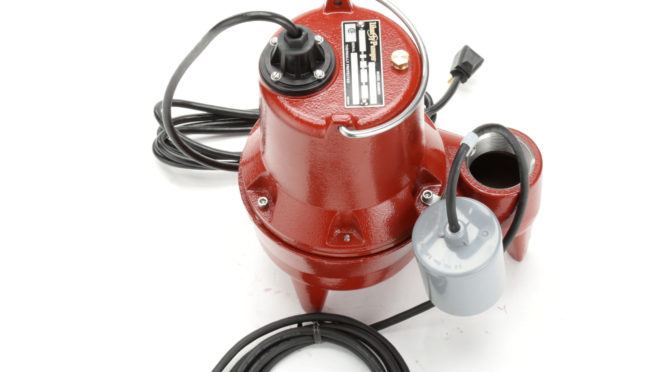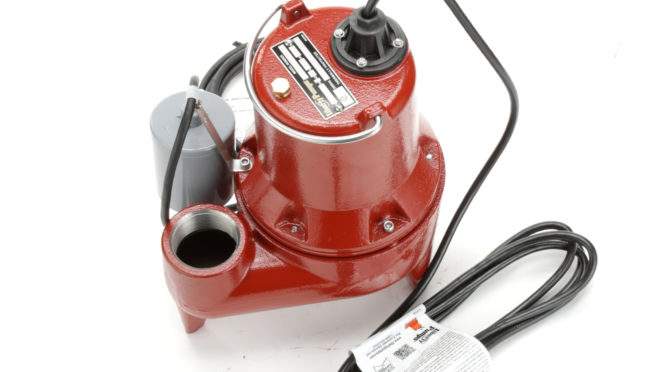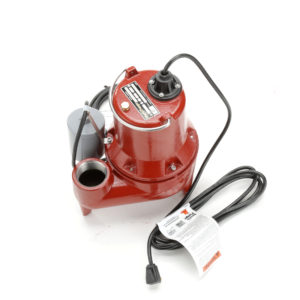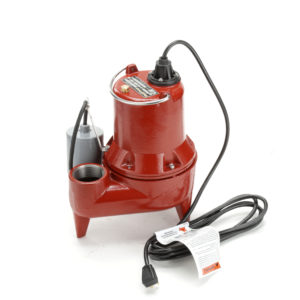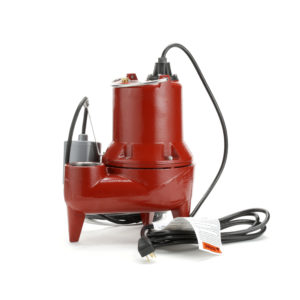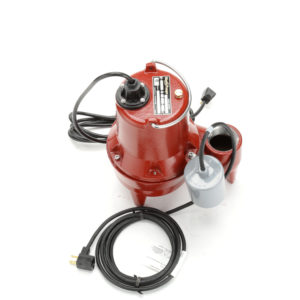 When it comes to sewage pumps, it can be tempting to try to spend as little as possible in order to offset the money you’ll spend on installation costs. But we’ve spent enough time in sewage pits and around septic tanks to regret every dollar we’ve ever tried to save by buying unreliable sewage pumps. To be frank, if you have a family or tenants who can’t tell the garbage can from the toilet, you need a grinder pump instead of a basic ejector pump. If, on the other hand, the people in your home or the people who rent your properties only use drains to flush human waste, then you’ll be able to get by with a regular sewage pump. In either case, you don’t want something you’ll find in your local big box store. There’s too much at stake.
When it comes to sewage pumps, it can be tempting to try to spend as little as possible in order to offset the money you’ll spend on installation costs. But we’ve spent enough time in sewage pits and around septic tanks to regret every dollar we’ve ever tried to save by buying unreliable sewage pumps. To be frank, if you have a family or tenants who can’t tell the garbage can from the toilet, you need a grinder pump instead of a basic ejector pump. If, on the other hand, the people in your home or the people who rent your properties only use drains to flush human waste, then you’ll be able to get by with a regular sewage pump. In either case, you don’t want something you’ll find in your local big box store. There’s too much at stake.
Let’s say you want a sewage grinder pump. The Liberty Pumps PRG101A costs under a grand and will keep your sewage system from clogging no matter what’s thrown in it for a good 15-25 years. But if you’re sure you don’t need a grinder and just need to pass solids with reliability, you can save a lot of money. There’s the Zoeller M267, which is one of the most trusted ejectors out there, as well as the Liberty Pumps LE51A. Today we’re going to examine the LE51A’s little sibling, the Liberty Pumps LE41A Submersible Automatic Sewage Pump. To summarize our review, it’s not nearly as reliable as the LE51A due to faulty float switches, and we’d recommend getting that instead. That said, you can buy the LE41 here.
Key Features of the Liberty Pumps LE41A Sewage Ejector Pump (60 Second Summary)
 The Liberty Pumps LE41A is an automatic submersible sewage ejector pump aimed at residential (household) applications. It’s not designed to be used in commercial (business) environments (unlike the LE51A). It includes a 4/10 horsepower electric motor, a 8,700 gallon per hour maximum flow rate, a 20 feet maximum pumping height, and Liberty Pumps’ 3 year warranty. It stands 13.8 inches high, is 7.5 inches wide, and 10.9 inches long. The LE41A weighs 40 pounds and has a motor housed in class 25 cast iron.
The Liberty Pumps LE41A is an automatic submersible sewage ejector pump aimed at residential (household) applications. It’s not designed to be used in commercial (business) environments (unlike the LE51A). It includes a 4/10 horsepower electric motor, a 8,700 gallon per hour maximum flow rate, a 20 feet maximum pumping height, and Liberty Pumps’ 3 year warranty. It stands 13.8 inches high, is 7.5 inches wide, and 10.9 inches long. The LE41A weighs 40 pounds and has a motor housed in class 25 cast iron.
the LE41A features a polymer impeller that can handle 2 inch spherical solids. It includes an oil filled, thermally protected motor . The motor takes 115 volts single phase AC with a maximum amp draw of 12 amps and locked rotor amps at 22.5. Thermal overload protection kicks in at 221F. A 10-foot quick disconnect power cord comes with the LE41A by default; the LE41A-2 is identical in every way besides substituting a 25-foot power cord. The pump can handle liquids at up to 140F and includes an automatic mechanical wide angle float switch and piggyback plug. It includes a 2 inch FNPT discharge.
The maximum pumping speed of 8,700 GPH at zero feet scales down to 6,000 GPH at 10 feet with shutoff and max head occurring at 20 feet.
How Does the Liberty Pumps LE41A Compare to the Zoeller M267, Liberty Pumps LE51A, and PRG101A?
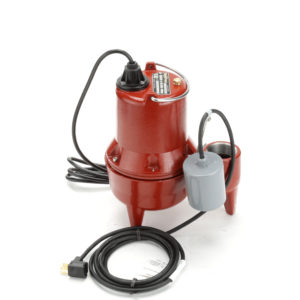 The LE41A is faster than the M267 (8,700 GPH vs 7,680 GPH) but slower than the LE51A (which tops out at 9,600 GPH). It has a lower max head than both (21.5 feet and 24 feet respectively). Warranty coverage is the same as both at 3 years, as is solids-passing capability at 2 inches. The LE41A is underpowered compared to both at 4/10 horsepower vs 1/2 horsepower and also has a significantly poorer reputation for long term reliability due to a poor float switch design; we’d expect a lifespan of 5-10 years for the LE41A vs up to 15 years for the LE41A and up to 20 years for the M267. Given the small price difference between the three pumps, we’d recommend the M267 or LE51A over the LE41A whenever possible.
The LE41A is faster than the M267 (8,700 GPH vs 7,680 GPH) but slower than the LE51A (which tops out at 9,600 GPH). It has a lower max head than both (21.5 feet and 24 feet respectively). Warranty coverage is the same as both at 3 years, as is solids-passing capability at 2 inches. The LE41A is underpowered compared to both at 4/10 horsepower vs 1/2 horsepower and also has a significantly poorer reputation for long term reliability due to a poor float switch design; we’d expect a lifespan of 5-10 years for the LE41A vs up to 15 years for the LE41A and up to 20 years for the M267. Given the small price difference between the three pumps, we’d recommend the M267 or LE51A over the LE41A whenever possible.
Compared to the Liberty Pumps PRG101A, the sole advantages of the LE41A are pumping speed (8,700 GPH vs 2,760 GPH) and price. In every other category, the PRG101A is easily the superior sewage pump. As a grinder pump, it’s designed to handle all kinds of difficult solids (feminine hygiene products, towels, rags, wipes, and more) that would choke or clog the LE41A or any other sewage ejector pump, including the LE51A and M267. If you’re serious about keeping your sewage system running no matter what family members, tenants, or employees and customers flush down it, you don’t want an ejector pump–you need a grinder pump.
Our Short and Long Term Experiences Installing and Using the Liberty Pumps LE41A Ejector Pump
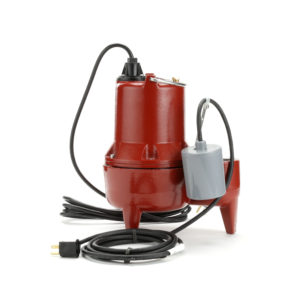 Installing the LE41A is pretty much the same as the process for any other sewage ejector pump–potentially more complex than a sump pump installation due to the location, but not impossible. If you hire a plumber, of course, it’ll be faster, though more expensive. If you’ve got experience with sewage pumps or know someone who does, you’ll be able to get through it; there aren’t any ugly surprises to be aware of. Just make sure you have all of your accessories and extras on hand before you start; you don’t want to stop in the middle of a project because you’ve broken a coupling and don’t have any spares and the hardware store is closed for the night. As usual with sewage jobs, it would be smart to buy and use a good wet / dry vacuum to keep things as clean as possible.
Installing the LE41A is pretty much the same as the process for any other sewage ejector pump–potentially more complex than a sump pump installation due to the location, but not impossible. If you hire a plumber, of course, it’ll be faster, though more expensive. If you’ve got experience with sewage pumps or know someone who does, you’ll be able to get through it; there aren’t any ugly surprises to be aware of. Just make sure you have all of your accessories and extras on hand before you start; you don’t want to stop in the middle of a project because you’ve broken a coupling and don’t have any spares and the hardware store is closed for the night. As usual with sewage jobs, it would be smart to buy and use a good wet / dry vacuum to keep things as clean as possible.
Once installed, we wish we could say you could expect decades of life from the LE41A, but we’ve seen or heard about enough failed pumps to have trouble trusting this model for longevity. The most common issue we seem to see is the float switch getting suck, whether in the on or in the off position; we’ve got guides for dealing with that below, but you’re not going to want to keep going into the pit to fix this every few years. We’d recommend just buying the LE51A instead if you want the same pump with better reliability. Alternatively, the most reliable ejector we’ve found is still the M267, while the most reliable sewage pumps overall won’t be ejectors but grinders, and the PRG101A is the best under a grand you’ll find.
Troubleshooting and Installation Tips to Get Your Liberty Pumps LE41A Working Sooner
When installing the LE41A, the main issues to watch out for are the pump itself not running once installed or its counter, the pump refusing to turn off.
If it doesn’t run, you’ve got one of four issues: poor power, poor liquid levels, a stuck switch, or a bad switch. For power, make sure you’ve got good voltage and that you don’t have a blown fuse. For liquids, make sure there’s enough in the pit to actually trigger the switch. For a stuck switch, make sure there’s nothing blocking the switch from moving through its full range of motion. And for a bad switch, you’ll simply have to pull it and replace it.
If the pump doesn’t turn off, your issues are much simpler: your switch will either be stuck in the open position due to being blocked by something in the pit, or the switch itself will be defective and need pulling.
Liberty Pumps LE41A Sewage Pump Pros, Cons, and Value Comparison
In conclusion, while the LE41A is one of the cheaper “serious” sump ejector pumps on the market, we can’t recommend it in good faith when it falls so close in price to the Zoeller M267 and Liberty Pumps LE51A, both of which are far superior sewage pumps in the $300 price range. Both of those pumps can be used in both residential and light commercial applications, while we’d be hesitant to use the LE41A in anything but single-family home setups. That said, if you’re looking for rock solid reliability and manage a home or business with a high risk of tough solids like sanitary wipes or feminine hygiene products being flushed down toilets and drains, you’d be better off bypassing the M267 and LE51A and upgrading to a dedicated sewage grinder pump like the PRG101A. The cost of doing so will be significantly cheaper than even one emergency plumber call and replacement ejector pump.
You can buy the Liberty Pumps LE41A here on Amazon or the LE41A-2 with a 25-foot cord here. You can buy the Liberty Pumps LE51A here. You can buy the Liberty Pumps PRG101A here. You can buy the Zoeller M267 here. You can buy a good wet / dry vacuum here. You can buy a silent 2 inch check valve here.
If you find our work at PumpThatSump helpful, you can support our relentless reviewing of every sump pump on the market by shopping via our Amazon link for whatever you need to make your house a home. Despite being self-employed, we promise not to spend it all on health insurance.
